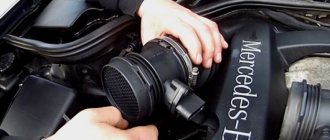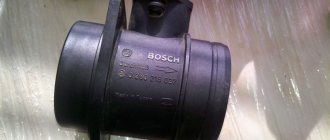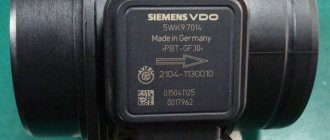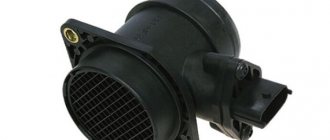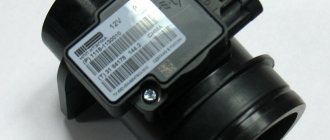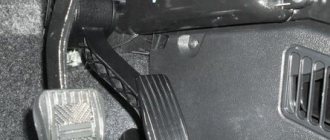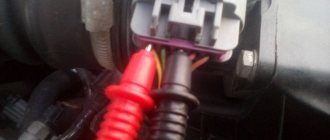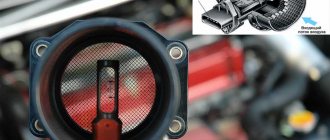Injection (injection) engines on VAZ 2107 vehicles are equipped with a time-tested mass air flow sensor from Siemens.
Of course, there is no German magic here; the sensor can fail, like any other equipment. The car will not stop, the engine will not stall, but the control electronics will switch it into emergency mode. That is, the air entering the intake manifold will not be taken into account by the main “brain”; in this case, the fuel mixture is formed according to the average principle. Gasoline consumption increases, power and torque decrease.
Design and purpose of the air flow sensor VAZ 2107
The electronic engine control unit receives information about the amount of air entering the combustion chambers of the cylinders. Based on these data, the dosage of gasoline intake is calculated to form the optimal composition of the air-fuel mixture. DMRV VAZ 2107 (injector) is installed between the air filter and the throttle valve. The speed of air flow passing through the sensor is measured by monitoring the temperature of the electrical conductors. The sensor contains two conductive platinum threads. One is blown by passing air, the second serves for control. The passing air cools the first conductor and its resistance decreases. The degree of cooling, and, consequently, the amount of air passed, can be determined by the difference in resistance of the two threads: the larger the volume of air passes, the more the conductor is cooled and the more its resistance decreases. Specific calculations are made by the on-board computer based on algorithms that take into account not only the difference in the resistance of the threads, but also the current temperature of the control conductor.
Video review
Diagnostics of VAZ ECM using ELM327 version: 1.4.2b
Last update of the program in the header: 10/20/2013
Brief description: Working with the ELM 327 adapter via Bluetooth, reading/resetting ECM errors, displaying ECM parameters January 7.2/7.2+, BOSCH 1.5.4.
Description: The program is designed to read/reset ECM errors (DTC) of a VAZ using the ELM 327 Bluetooth adapter and Android devices. For now, work with ECM units “JANUARY 7.2/7.2+”, “JANUARY 5”, “BOSH 1.5.4” is supported. I myself “run” it only on my car with the January 7.2 block, so I can’t guarantee it will work with other blocks, because There is no way to check on other cars. I'm currently posting the first working version (beta version). Perhaps I will continue development in the future. The program is free. I will be happy to listen to comments, suggestions, objections and indignations. Write 
Russian interface: Yes
Developer: Alexxx753
After pressing the error reset button, you need to update the list with the corresponding button (this is the case for now, but the comment has been accepted - I’ll redo it: yes2: ). What about zeros - is this always the case? Didn’t show any value at all?
I tried it on two cars. 2114 2006. since January everything is fine, resets, reads, finds. And on a Priora 2012 with EGAZ and it seems like a god 17, here I found a jamb, found it, wrote what you were reading. Esud and that's it. not a word more. And I’m very grateful to the author for the work done. The most interesting thing is that they used to read the talk with the obd doctor, but then suddenly they stopped. Oh yes, the phone Xperia ZR and Acer Iconia A 501
Reading time
Difficulty of the material:
For the pros - 4 out of 5
The ELM327 diagnostic adapter is widely popular among motorists. It allows you to carry out a quick computer service of electronic modules and track the values of important parameters of the internal combustion engine in real time. The adapter is easy to use and does not require special skills from the owner. The device is actively used for diagnosing not only foreign brands, but also domestic cars.
The ease of working with ELM327 is obvious - just connect the device to the service connector and synchronize it with your computer. The information will be displayed on the display of your PC or smartphone.
In this article you will learn:
Important:
Older models may be equipped with an OBD2 connector, but do not support available ISOs. Such blocks are diagnosed using separate tools.
How malfunctions of the VAZ 2107 mass air flow sensor are detected
The first sign by which you can determine whether there is a problem with the sensor is a burning “Check engine” light on the dashboard along with the corresponding error code issued by the on-board computer. In addition, malfunctions of the mass air flow sensor are expressed in the following “symptoms”:
- increased fuel consumption;
- unstable idle speed;
- reduction in vehicle power or dynamics;
- increased or decreased idle speed;
- Difficulty starting the engine (especially when hot).
The above symptoms appear not only when the mass air flow sensor breaks down. However, if they appear, you should check the VAZ 2107 mass air flow sensor. The design of the sensor does not provide for its repair, so if it breaks, it must be replaced.
Tip: one of the reasons for sensor errors is damage to the air duct between the air filter and the throttle valve. Before changing the mass air flow sensor, you need to check its condition.
In some cases, the mass air flow sensor stops working due to contamination of the platinum filament. In this case, you can try to carefully clean it.
How to check the MAF sensor
An accurate check of the sensor's performance is possible only with the help of special equipment - a motor tester. This is an expensive device that only professional service stations have. At home, you can check the performance of the mass air flow sensor in simpler and cheaper ways. 1.Check by disconnecting the sensor. This is the easiest and fastest way to check the operation of the sensor “by eye”. This is done like this:
- disconnect the mass air flow sensor connector;
- start the engine;
- make a test drive.
Under such conditions, the engine ECU will go into emergency mode, ignoring the sensor reading. Accordingly, the composition of the air-fuel mixture will depend only on the readings of the throttle position sensor. If in this case the motor runs more smoothly or acceleration dynamics improve, the mass air flow sensor must be replaced. 2. Checking the operation of the VAZ 2107 mass air flow sensor using a multimeter is performed as follows:
- connect one multimeter probe to ground;
- turn on the ignition; measure the voltage at pin “5”;
- check the power supply circuit of the mass air flow sensor if the voltage is below 12 volts;
- check the voltage at terminal “4” of the mass flow sensor;
- a voltage of less than 5 volts indicates a malfunction of the computer or the sensor power circuit.
If no problems are found in the operation of the ECU and the power supply, it is necessary to replace the mass air flow sensor. 3. Visual inspection of the sensor can be done after removing it from the vehicle. The internal surface of the mass air flow sensor must be clean, free of oil deposits. At the same time, you should check the condition of the air duct from the filter to the throttle. Air leakage is one of the common causes of sensor malfunction. It is also necessary to make sure that the inlet grid of the mass air flow sensor is not oily or covered with dust. If it becomes dirty, it can be cleaned and the sensor will resume operation. Another part that affects the operation of the mass air flow sensor is the o-ring. If it is damaged, air leaks and the sensor stops working correctly.
Interchangeability
This issue is quite relevant, especially taking into account the cost of original products from the imported automobile industry. But it’s not so simple here, let’s give an example
In the first production models of the Gorky Automobile Plant, the injection Volgas were equipped with a BOSCH air flow sensor. Somewhat later, imported sensors and controllers replaced domestic products.
A – imported filament air flow sensor manufactured by Bosh (pbt-gf30) and its domestic analogues B – JSCB “Impuls” and C – APZ
Structurally, these products were practically no different with the exception of several design features, namely:
- The diameter of the wire used in a wirewound thermistor. Bosch products have a diameter of 0.07 mm, and domestic products have a diameter of 0.10 mm.
- The method of fastening the wire differs in the type of welding. For imported sensors this is resistance welding, for domestic products it is laser welding.
- Shape of a thread thermistor. Bosh has a U-shaped geometry, APZ produces devices with a V-shaped thread, and products from JSC Impulse are distinguished by the square shape of the thread suspension.
All the sensors given as an example were interchangeable until the Gorky Automobile Plant switched to film analogues. The reasons for the transition were described above.
Film air flow sensor Siemens for GAZ 31105
It makes no sense to give a domestic analogue to the sensor shown in the figure, since outwardly it is practically no different.
It should be noted that when switching from filament devices to film devices, most likely, it will be necessary to change the entire system, namely: the sensor itself, the connecting wire from it to the ECU, and, in fact, the controller itself. In some cases, the control can be adapted (reflashed) to work with another sensor. This problem is due to the fact that most filament flowmeters send analog signals, while film flowmeters send digital signals.
It should be noted that the first production VAZ cars with an injection engine were equipped with a filament air flow sensor (made by GM) with a digital output; examples include models 2107, 2109, 2110, etc. Now they are equipped with a BOSCH 0 280 218 004 mass air flow sensor.
To select analogues, you can use information from official sources or thematic forums. As an example, below is a table of the interchangeability of mass air flow sensors for VAZ cars.
Compatibility table for mass air flow sensor for the VAZ model range
The presented table clearly shows that, for example, the MAF sensor 0-280-218-116 is compatible with VAZ 21124 and 21214 engines, but is not suitable for 2114, 2112 (including those with 16 valves). Accordingly, you can find information on other VAZ models (for example, Lada Granta, Kalina, Priora, 21099, 2115, Chevrolet Niva, etc.).
As a rule, there will be no problems with other brands of cars of domestic or joint production (UAZ Patriot ZMZ 409, Daewoo Lanos or Nexia), choosing a replacement mass air flow sensor for them will not be a problem, the same applies to products of the Chinese automobile industry (KIA Ceed, Spectra, Sportage etc.). But in this case, there is a high probability that the MAF pinout may not match; a soldering iron will help correct the situation.
The situation is much more complicated with European, American and Japanese cars. Therefore, if you have a Toyota, Volkswagen Passat, Subaru, Mercedes, Ford Focus, Nissan Premiere P12, Renault Megane or another European, American or Japanese car, before replacing the mass air flow sensor, you need to carefully weigh all the solution options.
If you are interested, you can search online for an epic about an attempt to replace the “native” air meter with an analogue on a Nissan Almera H16. One attempt resulted in excessive fuel consumption even at idle.
Read more: Treatment of thresholds with bitumen mastic
In some cases, searching for an analogue one will be justified, especially if you take into account the cost of the “native” VU meter (for example, the BMW E160 or Nissan X-Trail T30)
How to replace the MAF sensor VAZ 2107
To replace the sensor, you must perform the following steps:
- Use a 8mm wrench or a screwdriver to loosen the clamp holding the air duct;
- remove the air duct sleeve from the MAF outlet pipe;
- Using a 10mm wrench, unscrew the bolts securing the sensor to the air filter;
- remove the mass air flow sensor from the car;
- remove the rubber o-ring from the sensor;
- install a new sensor on the air filter, putting the O-ring on it;
- tighten the two sensor mounting bolts;
- put on the air line and tighten the clamp. This completes the replacement of the VAZ 2107 air flow sensor. You can test the operation of the engine.
Drive unit
Drive shaft, CV joint (grenade), Outer CV joint, Inner CV joint, Right CV joint, Left CV joint, CV boot, Tripoid, CV joint nut, Retaining ring, Cardan, Crosspiece, Suspension bearing, Cardan bearing, Elastic coupling, Axle, Front axle, Rear axle, Axle reducer, Gearbox bearing, Gearbox oil seal, Differential, All-wheel drive sensor, Haldex coupling, Differential bearing, Differential oil seal, Planetary gears, Axle bearing, Axle shaft, Axle shaft bearing, Axle oil seal, Axle shank, Shank bearing, Axle bearing, Transfer case, Transfer case, Transfer case oil seal, Transfer case bearing, Transfer case chain
VAZ 2110 air sensor pinout diagram
- Yellow (closest to the windshield) - mass air flow sensor signal input;
- Gray-white—sensor supply voltage output;
- Green — sensor grounding output;
- Pink-black - to the main relay.
The wire colors may change, but the pin locations remain the same.
Let’s also add that the mass air flow sensor with endings 004, 037, 116 (for Bosch) and 00, 10, 20 (for Pekar) are different in calibration. You can only change it by flashing it.
Characteristic
On VAZ cars, the mass air flow sensor is mounted between the air filter element and the throttle hose. Today, products from the manufacturer Bosch are very popular among compatriots. Regardless of whether it is a universal Bosch sensor or, for example, spark plugs, quality from a German manufacturer can always give a head start to domestic products. Let's look at the main characteristics of regulators models 116 and 037.
DMRV 116 is designed to control and convert the air flow that enters the motor into voltage. The data transmitted by the regulator makes it possible to determine the operating mode of the power unit and calculate the cyclic filling of the cylinders with air flow. This filling is carried out in steady-state operating modes of the motor, which last no more than 0.1 seconds.
Connecting the MAF air sensor VAZ 2112
If the mass air flow sensor is operational, then when the engine is running at 900 rpm, the volume of air used will be at least 10 kg per hour. When the speed increases to 2 thousand, this figure will increase to approximately 20 kg. If the volume of air at such speeds drops, the dynamics of the vehicle will also decrease, and accordingly, this will lead to a decrease in gasoline consumption.
If these indicators increase, this will also contribute to an increase in fuel volume. Deviations of the parameter by 2-3 kg should not be allowed, since in this case the operation of the power unit may be incorrect.
Cleaning
Quite often you can avoid replacing the mass air flow sensor by simply cleaning this engine element.
You should do the cleaning yourself in this way:
- Remove the pipe from the mass air flow sensor;
- Now remove the sensor from the pipe. Otherwise, high-quality washing will not work;
- To remove the sensor, arm yourself with sprocket keys in advance. Finding such kits is not a problem;
- Unscrew all the fasteners, remove the sensor from the pipe and assess its external condition;
- Often there are traces of oil deposits on the sensor. The purpose of cleaning is to make the device as good as new;
- Carburetor cleaner is often used to clean the air flow sensor;
- Inside the film there are sensors, which are small wires attached to a special resin. These elements must be carefully sprayed with cleaner so as not to damage the devices;
- Wait a while for the surfaces to dry. To speed up the process, use a can of compressed air;
- It is not uncommon to use alcohol instead of carburetor cleaner, which also works quite effectively;
- Proper cleaning of the mass air flow sensor involves treating the pipes from accumulated debris, dirt and dust;
- Having carefully processed all the components of the removed mass air flow sensor, wait until it dries, and then reassemble it. Cleaning is complete.
Spray cleaning Statistics show that in about 80% of cases, simple cleaning can return the mass air flow sensor to its previous functionality.
Price issue
80% is not 100. Therefore, sometimes you have to change the sensor. And to replace it, you need to buy it.
There are three price categories for air mass flow sensors:
- Cheap. These are predominantly Chinese products, the price of which is up to 1000 rubles. It is strongly not recommended to purchase such regulators;
- Average. These include sensors from AvtoVAZ, domestic and some foreign analogues. These cost from 1500 to 2500 rubles;
- Expensive. High-quality, reliable, imported air flow sensors, the price of which can reach 5.5 thousand rubles. It’s hard to say how rational it is to buy them. But they will definitely last a long time.
Connection diagram for air flow sensor 2114
A common cause of incorrect operation of the mass air flow sensor is the failure of electronic components, which increases the sensor’s response time to changes in air flow. A working sensor monitors changes at a speed of 0.5 ms, and if it breaks down, the response time increases by 20-30 times. The defect is detected only by recording the operation graph with an oscilloscope. Such a sensor cannot be repaired; it must be replaced with a new one.
Characteristic
On VAZ cars, the mass air flow sensor is mounted between the air filter element and the throttle hose. Today, products from the manufacturer Bosch are very popular among compatriots. Regardless of whether it is a universal Bosch sensor or, for example, spark plugs, quality from a German manufacturer can always give a head start to domestic products. Let's look at the main characteristics of regulators models 116 and 037.
DMRV 116 is designed to control and convert the air flow that enters the motor into voltage. The data transmitted by the regulator makes it possible to determine the operating mode of the power unit and calculate the cyclic filling of the cylinders with air flow. This filling is carried out in steady-state operating modes of the motor, which last no more than 0.1 seconds.
Let's look at the technical features that Bosch 0 280 218 116 has:
- the regulator operates on the principle of measuring air flow;
- the device provides accurate data, which ensures optimal fuel consumption;
- operating range varies from 8 to 550 kg/h;
- the output pulse level when measuring the range from 0 to 100% will be about 0.05-5 volts;
- As for power supply, the controller is powered from the vehicle’s electrical network, that is, 12 volts is enough for it;
- current consumption is about 0.5 ampere;
- the regulator can function normally in the operating range from 45 degrees below zero to 120 degrees;
- The service life of the Bosch 116 mass air flow sensor is about 3 thousand hours.
Bosch 116 device
As for the mass air flow sensor 037 from Bosch, the technical features will be similar. The controller consists of two main elements - working and control, as well as a heating resistor device. The air that enters the engine cools one of the controllers, while the electronic module converts the temperature differences between the controllers. In the event that sensor 280 218 037 fails, its options will be performed by TPS.
As mentioned above, the technical features of the models are the same:
- the operating range for normal operation varies in the region of 8-550 kg/h;
- when operating correctly, the controller will provide accurate data, making it possible to achieve optimal gas mileage (of course, if the engine is running in normal mode);
- since the element is used in a car, it is logical that it should be powered by 12 volts;
- the controller consumes about 0.5 ampere of current;
- the part can operate normally both at 45 degrees below zero and at 120 degrees of heat, this is its operating range;
- service life is at least 3 thousand hours;
- unlike model 116, the new mass air flow sensor 037 during calculations can produce an error of 2.5 percent (both downward and upward).
Checking the air sensor yourself
When a malfunction of the mass air flow sensor occurs, the air-fuel mixture becomes over-rich or lean, which immediately affects the operation of the engine and may ultimately result in engine failure.
Symptoms of a malfunctioning mass air flow sensor:
- Check Engine error appears;
- Increased fuel consumption;
- Doesn't start well when hot;
- The car began to accelerate slowly;
- Engine power lost.
The easiest way to check the mass air flow sensor on a VAZ 2114 is to disconnect the plug. If there is no signal, the engine control unit goes into emergency operation mode, determining the approximate air volume based on the throttle position. At the same time, fuel consumption increases slightly - for the VAZ 2114 it reaches 10-12 liters per 100 km. A characteristic feature is the increase in idle speed to 1500 rpm. But when using a January 7.2 or Bosch M7.9.7 controller, the idle speed does not increase due to the software features.
The normal voltage at the output of the new sensor is 0.996 - 1.01 Volts. During operation, it gradually changes and, as a rule, increases. The greater the value of this voltage, the greater the wear of the mass air flow sensor.
Here is the reference voltage in volts:
- 1.01 - 1.02 - good condition of the sensor.
- 1.02 - 1.03 - not a bad condition.
- 1.03 - 1.04 - the resource of the mass flow sensor is coming to an end.
- 1.04 - 1.05 - emergency condition.
- 1.05 and above - it’s time to replace the mass air flow sensor.
The measurement is made between the yellow and green wires. Voltage values can be displayed on the screen of some on-board computers (menu voltage from sensors, U Mass air flow sensor).
Important: the limits and fluctuations of the output voltage in at least 30% of cases for a faulty sensor will be NORMAL and will not cause the “Check” icon on the panel. That is, voltage measurements are not very informative, but the rate that it will produce in kilograms of air will correspond to the movement not where it actually is, and the ECU will interfere with the mixture based on it - hence the extra consumption!
You need to check the sensor at a service center, preferably with a proprietary scanner, which itself indicates by blinking if there is a imbalance in some parameter (in this case, air flow in kilograms), comparing it with the reference values stored in its memory.
Checking the electrical part with a multimeter
To find out what condition the electrical circuit of the mass air flow sensor is in, you will need to pinout the Siemens VDO contacts. First we check the block on the ECU side. We fix the negative wire of the multimeter to ground and turn on the ignition. We connect the positive wire to contact No. 5 of the block: normal supply voltage is 12 V. Similarly, we check contact No. 4; normal voltage is 5 V. If the values are different, check the ECU or the wiring harness from the mass air flow sensor to the engine control unit.
Important: The reason for the loss of supply voltage may be simple corrosion of the contacts; the operating conditions of the sensor are far from ideal.
How to check the sensor for the correct output signal? Using a diagnostic scanner (ideal) or the same multimeter. The output contact readings show not only the serviceability of the mass air flow sensor, but also the remaining resource.
Replacing the sensor - instructions
Using a screwdriver, unscrew the clamp of the air intake corrugation at the sensor outlet, pull it off and carefully inspect the internal surfaces of the sensor itself and the corrugation. These surfaces must be dry and clean; traces of condensation and oil are unacceptable. If the air filter is changed rarely, then dirt getting on the sensitive element of the sensor is the most common cause of its breakdown in VAZ cars.
There may be oil in the mass air flow sensor as a result of an increased oil level in the engine crankcase, or the oil sump of the crankcase ventilation system is clogged.
Next, unscrew the 2 screws of the sensor with a 10mm wrench and remove it from the air filter housing. There should be a rubber sealing ring on its front part (at the entrance edge). It prevents unfiltered air from being sucked into the intake tract through the sensor.
If the ring is out of place and stuck somewhere in the air filter housing, then there will be a thin layer of dust on the inlet mesh of the sensor itself. This is the second reason that destroys the mass air flow sensor ahead of time.
Correct assembly should take place in the following sequence: put a sealing rubber band on the sensor, check the sealing skirt, then insert everything together into the filter housing.
This concludes the visual check of the mass air flow sensor at home. You can check its operation 100% only with the help of special equipment in a car service center. For example, using a technique for assessing the oscillogram when the throttle is sharply opened to the cutoff mode (a motor tester is needed), or assessing the oscillogram when the ignition is turned on.
Resuscitation of a damaged air flow sensor is successful in no more than 5% of cases. In extreme cases, you can rinse with ethereal liquid to clean matrices and optics. It will evaporate without a trace. After making sure that there is no more dust or debris in the device, you can dry it thoroughly and put it back in place. Sometimes after such a simple procedure the device will work.
On most foreign cars, a mass air flow sensor was installed until 2000; subsequent generations of models began to be equipped with a pressure controller. Replacing a non-working sensor is simple and can be done on your own without any problems, you just need to buy a mass air flow sensor that matches the ECU firmware version. Its price is around 3,000 rubles, depending on the manufacturer.
In the design of sevens with injection-type engines, a mass air flow sensor is installed. The abbreviation stands for mass air flow sensor, which has a direct impact on the quality of engine operation. If the mass air flow sensor on a VAZ 2107 begins to malfunction, the engine will still work, but it is not recommended to operate it for such a long time. If this element breaks down, it should be replaced immediately.
Overview of the ELM 327 scanner and its connection
In general, I ordered the device from one of the sellers for about 500 rubles (something like $8) with free delivery. The parcel took two weeks. The scanner itself came with drivers and programs.
Now let's talk about how to connect the device to the car. Everything is quite simple here. Connect the 16-pin connector of the scanner to the “mother” on the car. It is made in the form of a trapezoid with a key. Therefore, do not connect it incorrectly, unless you hammer it in with a hammer. After connection, the rightmost LED (bottom in the photo) lights up red.
On your laptop, go to Device Manager. Almost certainly there will be such a picture.
And then, as the search location, specify the folder “ELM327 software\windows vista usb drive” on the CD included with the scanner (the seller additionally sent me links to download all the software). There is also a Mac OS Drivers folder on the disk. There, most likely, are drivers for owners of laptops from Apple.
The installation lasts a few seconds and USB Serial Port (COM3) appears in the “COM and LPT Ports” subsection of the Task Manager.
Mass air flow sensor on VAZ 2107
The injection engine is controlled by electronics that receive information from various sensors, adjusting the supply of the fuel-air mixture and ignition. The mass air flow sensor shows the volume of air supplied to the combustion chamber. Against the background of data received by the ECU, the dosage of gasoline is calculated, forming the optimal amount of the fuel-air mixture.
DMRV VAZ 2107 injector is located between the throttle valve and the air filter element (it is mounted in the pipe). The device in question is based on two electrical conductive threads. The principle of operation is based on temperature fluctuations of the first and second threads. To do this, one thread is located directly so that it is blown by the air sucked into the system, and the second is hidden from the influence of the air flow on it.
When air enters the system, the first thread cools, and at the same time the current resistance in the circuit decreases. The more air enters, the stronger the cooling process. The second thread is the control thread, and its resistance does not change. The difference in resistance between the first and second threads is recorded by the ECU, on the basis of which a decision is made on the need to enrich or lean the fuel mixture. If it breaks, the engine will continue to operate, but only in a mode in which the fuel mixture will be mixed in the wrong proportions.
Symptoms of malfunction
The malfunction of this sensor on the VAZ 2107 is indicated by the inclusion of the Check Engine control indicator. However, the absence of an indication does not always indicate the serviceability of the part in question. This is due to the fact that the part very rarely fails completely. Often its malfunction is manifested through incorrect readings. With such readings, the ECU receives a signal from the device, and accordingly makes an appropriate decision on the need to enrich or lean the mixture.
If there is a suspicion that the device in question is malfunctioning, then you need to pay attention to the following symptoms:
- An increase in fuel consumption is detected.
- The idle speed increases, and unstable engine operation is observed at idle.
- The car becomes less pliable by reducing power and dynamics.
- Problems with starting the engine when hot.
The MAF sensor is one of the most expensive spare parts, and if it breaks, it needs to be replaced. It cannot be repaired, but before replacing it, you need to make sure that the sensor is really faulty. If you suspect a device malfunction, you should first check the integrity of the air duct. After all, often the cause of DMRV errors is the intake of air from outside, bypassing the sensor.
Sensor failure may be minor when the surface of the platinum filament becomes dirty. In this case, it can be cleaned. First, let's figure out how to check the device for serviceability.
Checking the mass flow sensor with your own hands
The serviceability of the device in question can be determined with high accuracy only in a car service center that has specialized equipment. However, not every car service center has a special stand, and even if it does, it’s not good to go for diagnostics every time with the above-mentioned symptoms in order to find out the cause. Instructions on how to check the sensor at home include the following steps:
- Disconnect power from the device. To do this, disconnect the terminal from the sensor and start the engine. The engine will operate in emergency mode, relying only on the readings of the throttle position sensor. The operation of the motor is compared with the sensor disconnected. If the motor operates more stably in this mode, then the mass air flow sensor should be replaced.
- Checking the mass air flow sensor with a multimeter. To do this, you will need to connect the black probe of the device to the engine ground, and with the second one touch terminal “5”, having first turned on the ignition. If the device shows a voltage below 12V, then the power circuit needs to be checked. If the voltage is normal, then you should touch one probe to pin number “5”, and connect the second to the third pin of the sensor. If the element is working, the device will show a voltage of up to 1V, and a faulty mass air flow sensor appears if the voltage on the device is higher than 1V.
- Signs of failure of the mass air flow sensor on the seven can be determined by using a known good element. If, after installing a new sensor on a VAZ 21074, stable engine operation is detected, then the malfunction has been successfully detected.
On a VAZ 2107 injector, it is recommended to install a Siemens-branded air flow sensor made in Germany. MAF pinout for Siemens:
Removal and installation of the seven mass air flow sensor
If the part in question is faulty, it should be replaced. Replacing the air flow sensor on a VAZ 2107 is carried out according to the following instructions:
- The clamp that secures the air duct is loosened.
- After this, you need to remove the air duct pipe and unscrew the bolts securing the sensor to the filter.
- Disconnect the power supply from the device and remove the element from the car.
- A new sensor is installed, and finally it remains to tighten the clamp securing the air exhaust hose.
When the old mass air flow sensor is dismantled, you can clean it. Before cleaning the sensor, it must be disassembled. Platinum thread is cleaned with alcohol. The block connector must also be inspected for oxidation. Fixing a breakdown of the mass air flow sensor on the seven can be resolved quickly if it is clearly established that the cause is a faulty sensor.
Principle of operation
The piston stroke occurs when fuel is burned with air in a ratio of 1:14, maintaining which ensures optimal operation of the power plant. When the proportion decreases or increases, the engine does not stop working, but there is excessive fuel consumption or a decrease in engine operating power. We need a mass air flow sensor so that air flows in portions. The operation of the unit proceeds as follows: the VAZ 2110 air flow sensor calculates the portion of fresh air, and then sends the data to the main computer, which, based on this information, calculates the portion of fuel.
The harder you push the gas, the more filtered air the powerplant requires. The mass flow sensor detects the increase and commands the electronics to increase the amount of fuel. When moving at the same speed, each portion should be equal to the previous one. The mass air flow sensor receives data on the load of the power unit, and then calculates the required portion of air. When the driver presses the pedal, the throttle valve opens, thereby increasing the volume of intake air - the load increases. When the pedal is released, the load drops.
Damaged sensor due to dust
Information about the operation and design of the mass air flow sensor
Again, we will not consider the historically outdated mechanical options with a weather vane and the General Motors frequency flow meter, which was used in conjunction with the January 4-series ECU. Modern flow meters for the VAZ 10 series operate on the principle of a hot-wire anemometer.
It is based on the properties of some metals to significantly change resistance depending on heat (the MAF sensor uses an alloy of iridium with platinum, which causes the high cost of the device). There are two resistors in the air flow: one is precision, the second can change the resistance using heat. Voltage is applied to it, the thread is heated until it matches the standard. Depending on the strength of the air flow, the thread cools and the resistance changes. By increasing the voltage across the resistor, the temperature and, accordingly, the resistance are restored. This happens in real time, that is, the control of the air mass is constant. At the output, the mass air flow sensor displays the signal voltage with an accuracy of hundredths of a volt. The received information is processed by the ECU to accurately dose gasoline into the fuel-air mixture.
All elements are arranged into a single electronic model, which is placed in the measuring channel (air duct).
Sensor device
View of the flow meter from the grid side.
The sensor is disassembled.
The platinum thread is visible in this photo.
As a result, air flow and temperature are converted into electrical impulses understandable to the ECU. This is a very gentle and accurate device; it allows you to calculate the cyclic filling of the cylinders with air and updates the parameters every 0.1 s.
Mass air flow sensor diagram.
The working body of the sensor is a heated platinum thread. It heats up to operating temperature (from 100 to 1000 degrees), and when air enters, it cools down. The amount by which the filament temperature drops is converted into an electrical signal and, based on this value, the ECU calculates the mass and temperature of the air entering the combustion chamber. And based on this data, it prepares the required portion of fuel. In short - yes.
Visual inspection
As for visual diagnostics, first of all it is necessary to check the condition of the corrugation in which the flow meter is installed, as well as the device itself. If, as a result of the check, you see traces of motor fluid or condensation, then it is possible that the device does not work for this reason. In some cases, cleaning the device from contaminants allows the flowmeter to resume operation and prevent possible replacement. It should be taken into account that contaminants usually accumulate as a result of infrequent replacement of the air filter element (the author of the video about the regulator malfunction is the channel In Sandro’s Garage).
If you notice traces of engine fluid, then there is a possibility that the reason lies in a clogged oil seal, or the problem may lie in exceeding the permissible level of lubricant in the crankcase. When cleaning is complete, you will need to make a visual inspection of the regulator - on the front of it you can see the rubber seal that is used for sealing. The seal is necessary to prevent uncleaned air flow and it may be that the rubber band moves a little - this will lead to the accumulation of dust on the flowmeter grid.
Purifier selection options
How to clean the flow meter? The modern market offers many products for cleaning regulators; let’s look at the most effective options:
- Liqui Moly. This manufacturer, as you know, produces not only cleaning products, but also motor and transmission oils, as well as other types of liquids. If you believe the official information provided by the manufacturer, then this product belongs to the high-quality category. Accordingly, the cost of such a MAF cleaner will also be high. In fact, Liqui Moly cleaners cope with their tasks quite effectively - this product perfectly removes dirt from the sensor. If the flow meter was in working order at the time of cleaning, then after that it will work for a long time. The use of Liqui Moly is relevant in both gasoline engines and diesel power units.
- Alternatively, you can use alcohol to clean the device. This method is considered one of the oldest, but nevertheless the most effective. Due to its chemical properties, alcohol is good at removing clogs that accumulate on the sensitive component of the air flow sensor. Despite its effectiveness, today this method is not used so often and is usually used by unscrupulous technicians at service stations. The client pays for a special substance, for example, Liqui Moly, and in fact the cleaning is carried out using alcohol.
- The next option is fluid for carburetor engines. This option is considered one of the most effective and frequently used. Using carburetor fluid, you can effectively clean it, and as practice shows, such a product allows you to remove all contaminants.
- Another product sold in spray form is Liquid Key. This cleaner is used to remove all kinds of contaminants, not only from the flow meter, but also from other mechanisms and components.
- A universal tool for performing many tasks is WD-40. This liquid is used by our compatriots to clean all kinds of components, remove rust, get rid of squeaks, etc. Not so long ago, our car enthusiasts began to use it to clean flow meters (the author of the video is the Gen channel MB W140 Germany).
DF (Phase Sensor) or CPRV (Camshaft Position Sensor)
Determines the angular position of the camshaft. For eight-valve engines, it is fixed at the end of the block head. On a sixteen-valve engine there is about 1 cylinder on the block head.
Until about 2005, it was not installed on 8-valve engines, which means that fuel injection into the intake manifold will be carried out in pairs-parallel mode. That is, two injectors open at once.
The power units in which it is installed are characterized by phased injection, that is, only one injector nozzle opens into which fuel should be injected.
FAULTS: If it fails, the car automatically switches to pairwise-parallel mode, which leads to excess fuel consumption of 10-15%.
Costs about 250 – 400 rubles
As you can see, there are about eight main sensors in the system; once again I would like to remind you that in some modern units there can be much more of them. These same ones are found in any simple motor that is installed on hundreds of simple machines.
I’ll end here, sincerely yours AUTOBLOGGER
214,62
Similar news
Is it possible to put diesel oil into a gasoline engine? Which .
Boring the cylinder block. Why does the engine need it and can it be done?
How many valves are there in the engine? Let's look at rare cases
Source

